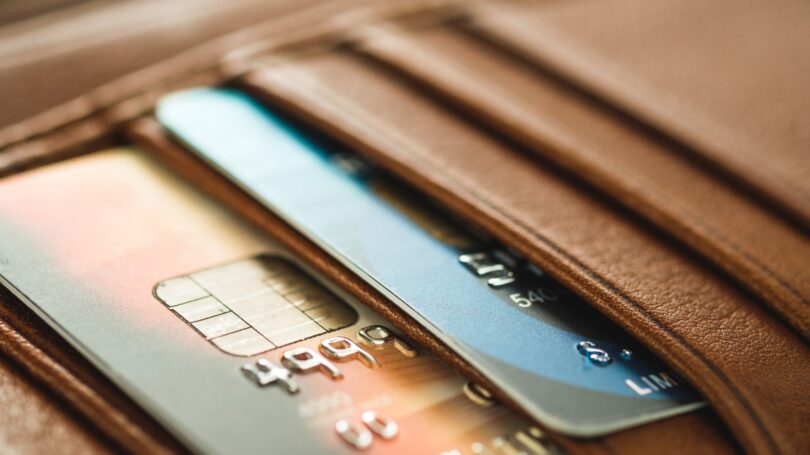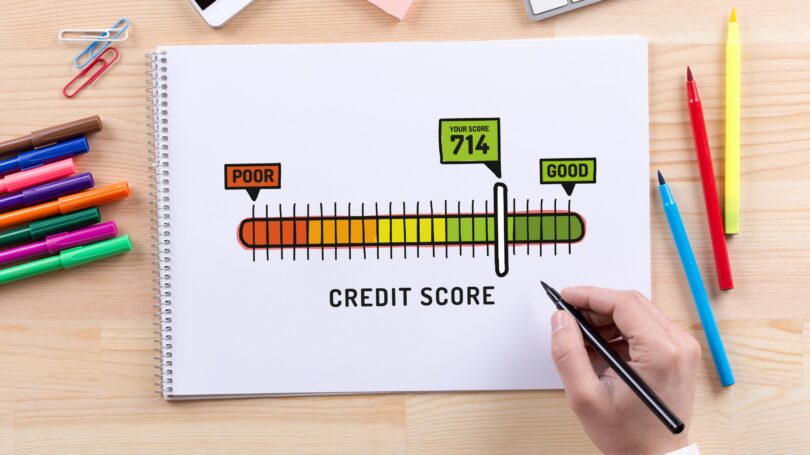Few life events are as stressful as bankruptcy. Every penny, asset, and source of income is put under the microscope for dissection. When it’s over and you finally receive your discharge or dismissal, you realize you’ve only reached the end of one set of challenges.
Yes, the bankruptcy and debt collection threats are behind you, and you have a fresh start. But a fresh start means starting over from scratch to rebuild your finances and re-establish your credit.
It isn’t a fast or easy process. But despite how much damage bankruptcy does to your credit, you can once again boast healthy finances and a high credit score with a methodical, step-by-step approach to post-bankruptcy rebuilding.
Step 1: Rewrite Your Budget

In all likelihood, it was a faulty budget that set the stage for your bankruptcy, even if some other event pushed you over the edge.
What went wrong? Why did your original budget fail? If you don’t understand where you went wrong, it’s hard to correct the problem. Before doing anything else after your bankruptcy discharge or dismissal, evaluate and rewrite your budget.
Fixed, Variable & Irregular Expenses
Start by writing out your current budget with three expense columns: Fixed, Variable, and Irregular.
In the first column, list your fixed monthly expenses. Include bills such as your housing payment and car payment that remain the same every month.
Under the next column, list all the variable costs you incur each month. Examples include food, clothes, and entertainment. Set aside an hour to look through your last three months’ bank statements and list out every penny you spent on variable expenses. Where are you overspending?
The third column is for irregular expenses – that is, costs that don’t come every month but do strike occasionally. Medical costs fall under this list, as does insurance you pay annually or semi-annually. Pay extra attention to your spending on gifts for others, such as holiday gifts, birthday gifts, wedding gifts, and baby shower gifts. Review your statements from the last year to find every penny you spent on irregular expenses.
Plugging the Holes in a Leaky Budget
Before going any further, identify your target savings rate. In other words, what percentage of your income would you like to save every month? Aim for at least 10%. With a clean slate post-bankruptcy, you’re in a position to get ahead financially.
Starting with the fixed expenses column, which expenses can you lower? Which can you erase entirely? Your home internet may be necessary, but is your cable TV subscription? Hardly. Get creative and brainstorm outside-the-box ways to save. Can you lower your housing costs by renting out a spare bedroom, for example?
Next, look over your average variable expenses. What would it take to cut that spending in half? Are you eating lunches out every day? Either pack a lunch or cook extra at dinner and bring the leftovers for lunch. Are you eating out at restaurants more than once or twice a month? Try cutting it to one meal out a month.
Finally, look at which of your irregular expenses you can trim, such as holiday gift spending. Then find somewhere out-of-sight, such as an account at a separate bank, where you can stow money for irregular expenses every month.
Keep chopping until you reach your target savings rate, then chop some more.
Budget Based on Four Weeks’ Income
Where so many consumers run into trouble is budgeting based on their annual income divided by 12. This leaves them basing their budget on an unrealistically high income because some months have more than four weeks. Remember that if you receive your paycheck every week, or every two weeks, you can only count on four weeks’ income in any given month.
Similarly, make sure you base your budget on your net, after-tax income. If your paycheck is $2,000 after taxes, every other week, then your monthly budget must be based on $4,000 per month.
Occasionally, you’ll have a month with an extra paycheck in it. Take advantage of those months by putting the “bonus” paycheck directly into your savings account.
Step 2: Set Up Savings

Your written budget should now earmark a certain percentage for savings. But there’s often a gap between saying you’ll save a certain amount every month and actually doing it.
How do you successfully bridge that gap and make sure the money you slated for savings ends up there? Follow these tips.
Automate Your Savings
The more visible and available your money is, the greater the temptation is to spend it. The trick is to move this money out of sight before you can touch it.
You probably have a checking account already, and perhaps a savings account with the same bank. If spending has been a problem for you in the past, go one step further and open a savings account with a different bank or credit union. That way, when you log into your online banking with your primary bank, you won’t see all that juicy savings sitting there just waiting to be spent.
Ask your employer if they can split your direct deposit. If they can, have your savings amount direct-deposited into your new out-of-sight savings account, while your “operating” income is deposited into your main checking account.
If your employer can’t split direct deposits, set up a recurring, automated ACH transfer from your checking account to your savings account. The crucial point is that it must take place within a day of your paycheck being direct-deposited, for every paycheck.
This way, your savings requires no work on your part. Sooner or later, discipline fails, so don’t rely on discipline.
Your Early Savings Target: An Emergency Fund
You’ve been on this earth long enough to know that unexpected bills happen. It could be a $1,500 car repair bill, a $3,000 home repair bill, or a $2,000 medical bill.
When the last unexpected bill came, what happened? You probably didn’t have the money, and it created a financial tailspin. But next time, you’re going to be ready.
How much do you need in an emergency fund? It’s a personal decision. In financial recovery post-bankruptcy, aim to keep more in cash than the average person might need. Start with a simple goal of $1,000 in your savings account. If you’re saving 10% of your net income, it won’t take you long to get there – a matter of months, most likely. Do a celebration jig when you reach $1,000 because you now have more money saved than 57% of Americans, according to GOBankingRates.
In the first year after your bankruptcy discharge, prioritize your emergency fund over investments. Aim for at least one month’s worth of expenses tucked safely away in your emergency fund.
Step 3: The All-Cash Budget

Swiping plastic makes it far too easy to spend money. In fact, credit cards almost certainly contributed to your bankruptcy.
You know what credit cards bring, and you don’t want to end up like the average American household, which has $5,700 in credit card debt, according to Business Insider. But even debit cards make it too difficult to track spending when you’re first restarting your financial life. To truly regain control over your spending, switch to using nothing but cash for the first three to six months.
Start by setting up a physical envelope system for spending. It will feel awkward and old-fashioned at first. But it works, and you will feel in complete control of your budget and spending. To prevent temptation, remove your debit cards from your wallet and put them in your bedside drawer. They will be relegated to the time-out box for the next few months.
The only exceptions to the ban on electronic payments are major recurring bills like your mortgage, car payment, and utilities. Every other expense must come out of the envelopes.
Feel silly with all these manual steps? Get over it and do it anyway. This is how you regain control over your finances – by resetting all of your old habits and creating new ones.
Step 4: Ease Back Into Debit Cards

After three months on the all-cash envelope system budget, how do you feel about your spending? Do you feel you have it completely under control?
You may decide to continue using the envelope system indefinitely. It’s an effective way to monitor and control spending. But electronic payments have their perks. If you’d like to transition back to plastic, start with a single spending category, such as food. Pull your debit card out of the drawer and put it back in your wallet. For the next month, use it only for food purchases. At the end of the month, add up all of your spending on the card and compare it to your previous cash spending on food. Did you spend more on your debit card? Why?
If you spent significantly more on food using your debit card, go another month only using your debit card for food purchases. Once your debit card spending is in line with your prior cash spending, expand to another category in the next month, then another. Keep expanding only if your spending in each category is on budget and comparable to your cash envelope system spending. Save entertainment as the final category to transition onto your debit card, as it’s often the most tempting.
Step 5: Start Rebuilding Your Credit

Chapter 13 bankruptcies remain on your credit report for seven years. Chapter 7 bankruptcies remain even longer, for 10 years.
That doesn’t mean you can’t improve your credit between now and then, but rebuilding your credit will take you several years. Strap in for the long haul, because there are no quick fixes here.
Begin by Checking Your Credit Report
The first step in repairing your credit after a bankruptcy discharge is pulling your credit report to review it. Wait three months after your discharge to give creditors a chance to update their reporting. Assuming you haven’t already done so within the last year, you can pull your credit report for free without a causing a ding to your score.
Look over your credit report in line-by-line detail. Your mission: to find and fix errors on your credit report.
After a bankruptcy discharge, most – if not all – of your debts should show a $0 balance. Exceptions can include tax judgments, or any debts in a payment plan, in the case of Chapter 13 bankruptcies. Are any of your debts showing an incorrect balance? For that matter, are there any debts showing that aren’t yours?
Credit bureaus and creditors make mistakes every day. It’s up to you to take responsibility for the accuracy of your credit report. If you see anything you find suspicious, contact the credit bureaus immediately to start the process of objecting and removing errors on your credit report.
The Pros & Cons of Credit Cards
Credit cards make it easy to overspend, but they can also be a good start in rebuilding your credit.
After you’ve fixed any errors on your credit report and transitioned back into using debit cards, weigh the pros and cons of opening a new credit card. Pros include the opportunity to rebuild your credit with no interest or fees, the flexibility of an emergency source of cash, and eventually qualifying again for cards with rewards.
The one giant, glaring con? Credit cards could put you right back where you started if you misuse them. Know thyself. If you don’t trust yourself yet with credit cards, leave them be.
If you’re ready for credit again, start with a secured credit card.
Secured Credit Cards
A secured credit card prevents you from overspending by limiting your card usage to your cash collateral.
When you request a secured credit card from a bank, credit union, or other card company, they require you to deposit cash with them as collateral. For example, you may need to deposit $1,000 in cash with your credit union. They hold that cash as security against your card usage, and your credit card limit will be $1,000.
Before opening a secured credit card, confirm that the card company reports to all three credit bureaus. The whole point, after all, is to rebuild your credit. Start your search with these top secured credit cards.
In the beginning, put only one fixed recurring bill on your credit card. Then, set up automated recurring payments to pay back the balance on your card account each month.
For example, say your home internet bill is $50 every month, charged on the 15th of the month. Set up automated billing so that the internet provider charges your credit card every month. Then, set up an automated recurring payment of $50 from your checking account to your credit card on the 16th of the month.
Keep your credit card tucked away in that bedside drawer for the first few months, with this one payment on autopilot. Ease back into credit card use the same way you eased back into debit cards.
Step 6: Start Investing

By now, you’ve saved a month’s expenses in your emergency fund. You’re comfortable with your budget, whether you’re continuing to use the cash envelope system or have transitioned back to electronic payments.
More conservative advisors, such as Dave Ramsey, recommend having three to six months’ expenses in an emergency fund. If that sounds high to you and you’re anxious to invest, put aside two months’ expenses in your emergency fund. After you reach your emergency fund goal, start transferring money into an investment account instead of your savings account.
Start with a tax-advantaged retirement account. If your employer offers a 401k or other retirement account, take advantage of it, especially if they offer matching contributions. It’s effectively a free raise!
If your employer doesn’t offer anything, open your own IRA. While the contribution limits are lower for an IRA, you have complete control over the investments.
Not sure what to invest in? Start with low-cost index funds. Aim for a mix of domestic and international funds that mimics major stock indices such as the S&P 500 and the Russell 2000. Don’t try to pick stocks or beat the market. For now, the key is that you’re investing money regularly and saving money on taxes.
Step 7: Only Borrow Secured Debt as Needed

Will you ever be able to buy a car again? A home? Yes. But until you’ve rebuilt your credit, it will be more expensive and come with more strings attached.
Car Loans
Within a year or two of your bankruptcy discharge, auto lenders may be willing to lend to you once more. However, don’t expect the same loan terms you enjoyed pre-bankruptcy.
Be prepared to pay higher interest rates. Lenders price based on risk, and your bankruptcy marks you as a high-risk borrower. Lenders will also expect a higher down payment from you.
Also, don’t be surprised if lenders ask you for a co-signer on the loan. Be prepared to have that possibly awkward conversation with a friend or family member if you’re determined to get an auto loan.
With that said, you can and should still shop around for the best rate and terms. Just because you have a bankruptcy on your credit doesn’t mean you can’t try to negotiate for a better car loan. All lenders can do is say no, right?
Alternatively, you can always save money and buy a car in cash.
Mortgages
As with auto loans, you can still borrow money to buy real estate, but expect to pay more. That translates to a higher interest rate, higher lender fees and points, a higher down payment, and potentially a co-signer for added security.
Again, shop around, compare rates, and negotiate. Follow these tips to get approved for a lower mortgage rate.
It’s worth noting that different mortgage loan programs impose different bankruptcy rules. After a Chapter 7 bankruptcy discharge, borrowers must wait a minimum of two years before qualifying for an FHA or VA loan and at least four years for a conventional loan backed by Fannie Mae or Freddie Mac.
Lending rules for Chapter 13 bankruptcies are slightly more complex. Before qualifying for FHA or VA loans, borrowers must make their planned payments on time for at least a year, and the bankruptcy court must approve the loan request. For conventional loans backed by Fannie Mae or Freddie Mac, borrowers must wait two years from a discharge and four years from a dismissal.
One perk of FHA loans is the famously low down payment. As long as your credit score is above 580, you can qualify for a 3.5% down payment. For credit scores in the 500 to 579 range, FHA requires a still-reasonable 10% down payment.
Even if you qualify for a low down payment, consider putting down more. It can help you negotiate for a lower interest rate and lender fees. Also, as someone recovering from bankruptcy, the less you can lean on financing, the greater your odds of success. Use these tactics to save more for a down payment and put down more on your next home rather than less.
Final Word
The bankruptcy process is emotionally grueling. You never, ever want to be in that position of financial powerlessness again.
To put your financial house back in order, you’ll need to invest time and effort. Expect to spend several hours poring over your budget when you’re first evaluating your spending habits. Set aside several more hours to get your envelope system up and running smoothly.
Reviewing your credit report? Contacting the credit bureaus to contest erroneous reporting? Your Saturday mornings will be busy for the next few months.
But the end prize is a life without the constant stress of worrying about money, the sleepless nights, and the endless fiscal fights with your spouse. Follow the above steps, and sooner rather than later, your days of financial turmoil will be safely in the rearview mirror.
Are you rebuilding your finances after a bankruptcy? What has been your biggest struggle?